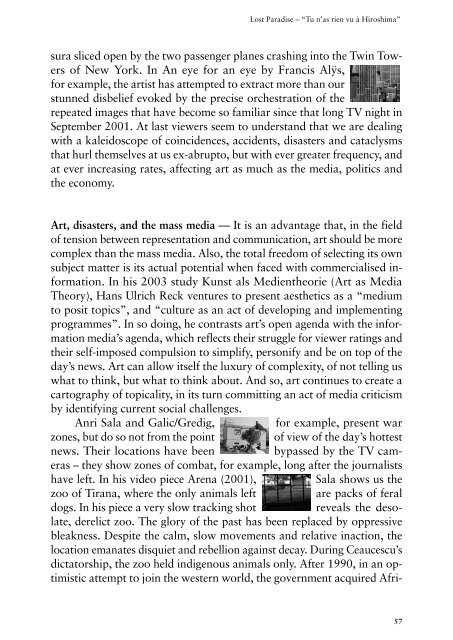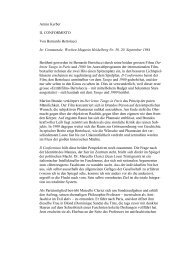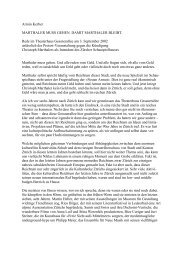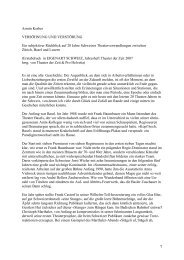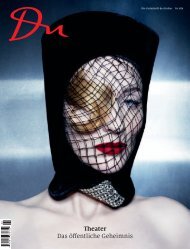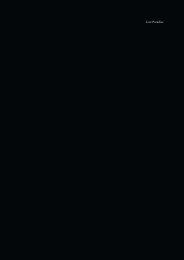You also want an ePaper? Increase the reach of your titles
YUMPU automatically turns print PDFs into web optimized ePapers that Google loves.
<strong>Lost</strong> <strong>Paradise</strong> – “Tu n’as rien vu à Hiroshima”<br />
sura sliced open by the two passenger planes crashing into the Twin Towers<br />
of New York. In An eye for an eye by Francis Alÿs,<br />
for example, the artist has attempted to extract more than our<br />
stunned disbelief evoked by the precise orchestration of the<br />
repeated images that have become so familiar since that long TV night in<br />
September 2001. At last viewers seem to understand that we are dealing<br />
with a kaleidoscope of coincidences, accidents, disasters and cataclysms<br />
that hurl themselves at us ex-abrupto, but with ever greater frequency, and<br />
at ever increasing rates, affecting art as much as the media, politics and<br />
the economy.<br />
Art, disasters, and the mass media — It is an advantage that, in the field<br />
of tension between representation and communication, art should be more<br />
complex than the mass media. Also, the total freedom of selecting its own<br />
subject matter is its actual potential when faced with commercialised information.<br />
In his 2003 study Kunst als Medientheorie (Art as Media<br />
Theory), Hans Ulrich Reck ventures to present aesthetics as a “medium<br />
to posit topics”, and “culture as an act of developing and implementing<br />
programmes”. In so doing, he contrasts art’s open agenda with the information<br />
media’s agenda, which reflects their struggle for viewer ratings and<br />
their self-imposed compulsion to simplify, personify and be on top of the<br />
day’s news. Art can allow itself the luxury of complexity, of not telling us<br />
what to think, but what to think about. And so, art continues to create a<br />
cartography of topicality, in its turn committing an act of media criticism<br />
by identifying current social challenges.<br />
Anri Sala and Galic/Gredig, for example, present war<br />
zones, but do so not from the point of view of the day’s hottest<br />
news. Their locations have been bypassed by the TV cameras<br />
– they show zones of combat, for example, long after the journalists<br />
have left. In his video piece Arena (2001), Sala shows us the<br />
zoo of Tirana, where the only animals left are packs of feral<br />
dogs. In his piece a very slow tracking shot reveals the desolate,<br />
derelict zoo. The glory of the past has been replaced by oppressive<br />
bleakness. Despite the calm, slow movements and relative inaction, the<br />
location emanates disquiet and rebellion against decay. During Ceaucescu’s<br />
dictatorship, the zoo held indigenous animals only. After 1990, in an optimistic<br />
attempt to join the western world, the government acquired Afri-<br />
57


